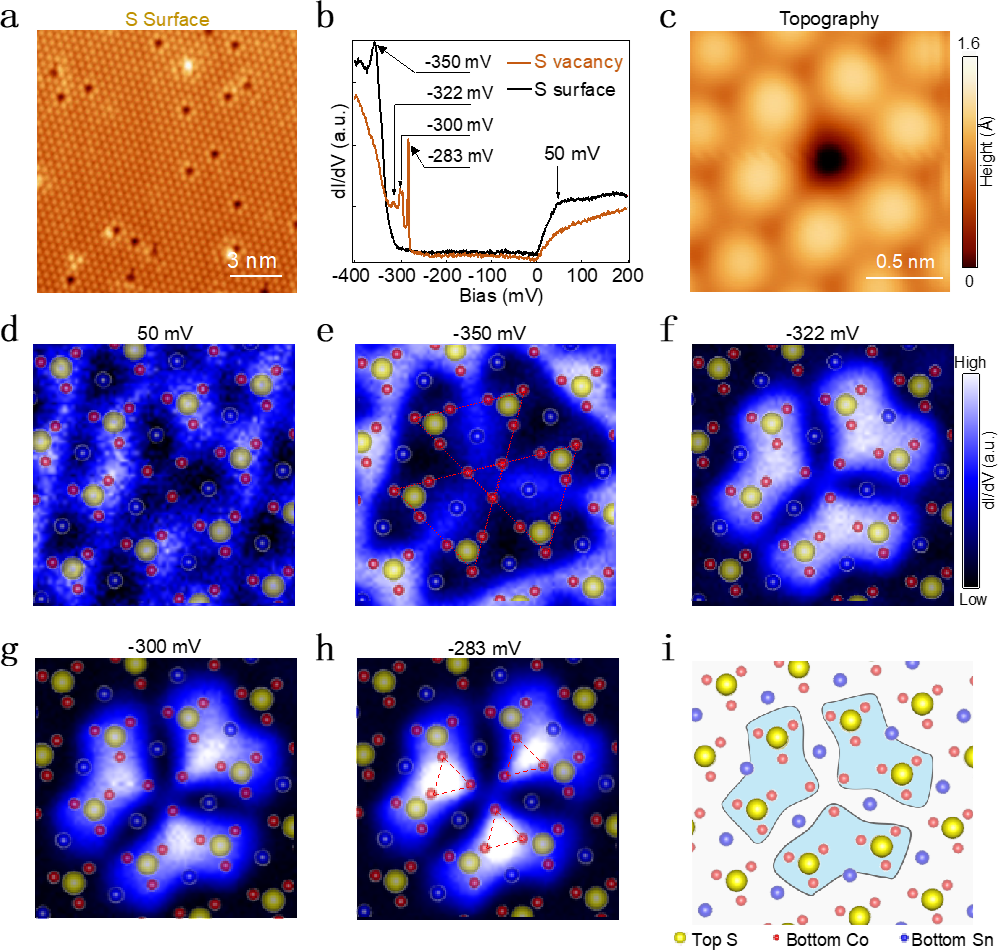
Recently, using ultra-low temperature scanning tunneling microscopy/spectroscopy (STM/S) with spin-polarized tip and low temperature atomic force microscopy (AFM), Prof. GAO Hongjun's research group at the Institute of Physics (IOP) of the Chinese Academy of Sciences, cooperating with Prof. LIU Enke from IOP and Prof. WANG Ziqiang from Boston College, USA, first studied localized excitations from single vacancies of magnetic Weyl semimetal Co3Sn2S2.
As the first combination of both theoretical prediction and experimental evidence Weyl topological system with intrinsic magnetism, Co3Sn2S2 has been discovered to exhibit novel phenomena such as surface-termination dependent topological Fermi arcs and disorder-induced elevation of intrinsic anomalous Hall conductance, making it an ideal platform to study the defect excitations and its correlation to the topological properties of the Weyl semimetal. Scanning tunneling microscopy/spectroscopy combining with spin-polarized tip is a powerful tool to characterize the local excitations at atomic level.
GAO's research group has solid research foundation in these two technologies and their research has achieved a number of international top-level research results.
The researchers used non-contact AFM and local contact potential difference measurement to identify the S-terminated surface from two typical cleaved surfaces. They reported the discovery of bound magnetic polarons nucleated around single S-vacancies in nearly non-magnetic S surface by spin-polarized STM. They emerged as bound states in the conductance map with a three-fold rotation symmetry.
Applying external magnetic fields up to ±6 T normal to the surface reveals that the binding energy of the localized magnetic polaron linearly increases as a function of the field magnitude regardless of the field direction. This anomalous response indicates dominant orbital magnetization contribution to the local magnetic moment. Contributed by the appreciable magneto-elastic coupling around the S-vacancy, they termed this new excitation as a localized spin-orbit polaron (SOP).
The significant diamagnetic orbital magnetization has a possible topological origin associated relating to the diamagnetic circulating current around the S-vacancy. The SOPs observed on nearly non-magnetic atomic layer of Co3Sn2S2 can enhance magnetism and more robust time-reversal-symmetry-breaking topological phenomena.
Given the role of magnetic dopants in dilute magnetic semiconductors, the vacancy-induced SOP may provide a new path toward generating magnetic moments in correlated nonmagnetic topological semimetals. Furthermore, the discovery of the localized SOP opens a novel route for manipulating the magnetic order and the topological phenomena in Weyl semimetal Co3Sn2S2. Controlled engineering of the SOPs may pave the way toward practical application in functional quantum devices.
This work entitled "Localized spin-orbit polaron in magnetic Weyl semimetal Co3Sn2S2" was published online in Nature Communications on November 5th, 2020. It was financially supported by National Natural Science Foundation of China, the National Key R&D Program of China, and the Chinese Academy of Sciences.

Fig. 1. Identification of S-surface of Co3Sn2S2 using nc-AFM/STM (Image by IOP)

Fig. 2. Localized excitations around a single S-vacancy at the S-terminated surface of Co3Sn2S2 (Image by IOP)

Fig. 3. Spin-polarized bound states at a single S-vacancy (Image by IOP)

Fig. 4. Anomalous Zeeman shift of the bound states and spin-orbit polaron at a single S-vacancy (Image by IOP)

86-10-68597521 (day)
86-10-68597289 (night)

52 Sanlihe Rd., Xicheng District,
Beijing, China (100864)

